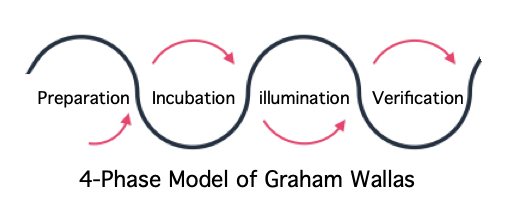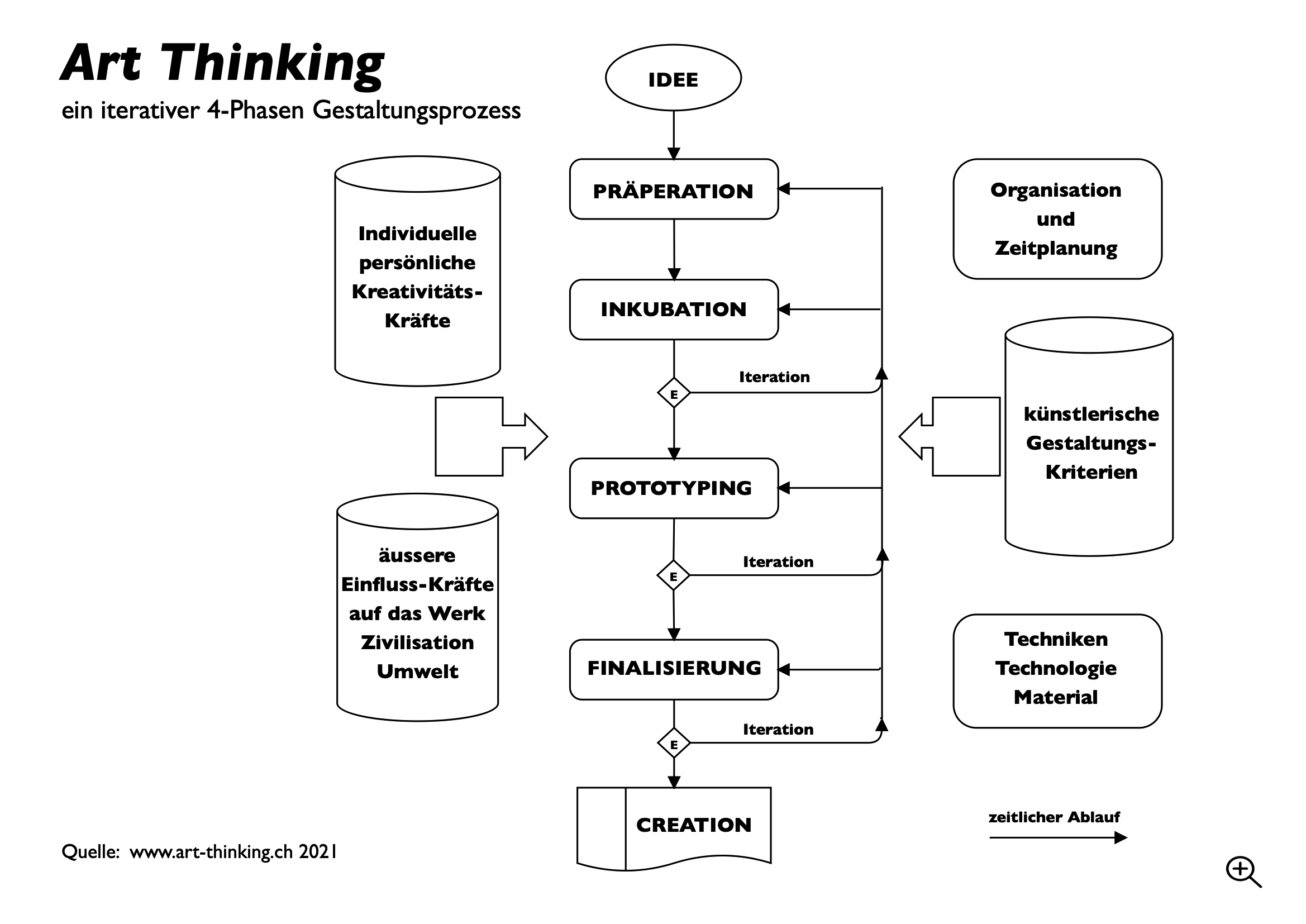The 4-Phase Model of Graham Wallas
One of the first modern models of human creativity came from Graham Wallas, an English social psychologist and co-founder of the London School of Economics.
This model goes back to observations made by the physicist Hermann von Helmholtz (1884) and the mathematician Henri Poincaré (1908). In 1926, Graham Wallas combined these observations with his own research into a systematic theory of creative thinking and propagated the following four-phase model of every creative process as follows:
The 4 phases of a creative process (Preparation, Incubation, illumination, Verification) introduced by Wallas in his book “The Art of Thought”, 1926 are still considered to be the universal phases which almost always appear in a similar or analogous way during every creative thought work and every problem-solving-oriented thinking and which of many creative people have been confirmed.
According to Wallas, the mental work is divided into four phases (1) first the task is formulated and (divergently) examined in all directions, (2) ideas and combinations are internalized in the subconscious and subconsciously hatched, (3) illuminations and sudden ideas then lead as from itself to a solution concept, which (4) can then be concentrated and implemented in the last phase of the creativity process (convergently).
As you will see, Wallas’ process model of creativity already contained the elements of today’s highly topical design thinking method. The methodology of design thinking according to HPI transfers Graham Wallas’ process model from the originally individual level to the levels of collective team and group work.
The design thinking method according to IDEO and HPI Hasso Plattner Institute
The Design Thinking method as practiced by IDEO and the Hasso-Plattner Institute at Stanford University is based on similar principles and procedures. Both approaches aim to find innovative solutions to complex problems and to place the user at the center of the design process. However, there are some differences between the two methods:
IDEO is considered a pioneer and forerunner of design thinking and developed the method in the 1990s.
The Hasso-Plattner Institute at Stanford University has further developed the design thinking approach and offers a structured framework for its application.
Process structure
IDEO uses a five-step design thinking process consisting of the phases of
Understanding –> Observing –> Generating Ideas –> Prototyping –> Testing
The Hasso-Plattner Institute has implemented a six-step process that adds the ‘Empathize’ stage before the ‘Understanding’ stage. This puts a stronger focus on understanding user needs and emotions, tools and methods:
Empathizing–> Understanding –> Observing –> Generating Ideas –> Prototyping –> Testing
Both methods use similar tools and methods, such as interviews, observations, brainstorming, prototyping, and testing. However, the specific application and weighting of the various tools may vary depending on the method.
Context and scope
IDEO is a global design and innovation company that applies design thinking to a variety of fields including product design, service design, corporate strategy and social innovation.
The Hasso-Plattner Institute mainly focuses on the application of design thinking in the context of technology and IT systems.
Despite these differences, both approaches share the core idea of design thinking, namely the creation of user-centric solutions through an iterative and collaborative design process. Both methods have a strong influence on innovation practice and are used worldwide by companies, organizations and educational institutions.![]()
![]()
4-Phase Model of Art-Thinking – The Algorithm of Creativity
The design process presented as a flowchart
From the idea to the creation, from rough to fine to the last detail, the process and the phases of creative artistic work are examined in their development over time and with reference to their influencing forces, goals and boundary conditions.
On the left and right side of the illustration are the most important forces influencing the creative process as well as the influence of craftsmanship, the underlying techniques, technologies and materials. These are:
- Individual personal creative powers
- Project Organization and scheduling, financing
- General artistic design criteria
- Techniques, technologies and materials
- External influences on the work, civilization, environment
Organization and scheduling of a project as a whole and on a daily basis are also considered essential for the process flow and included in the considerations.
The four phases of the artistic design process
Based on the considerations of Graham Wallas (1926), who discovered and developed a four-stage creation process with the four phases of preparation, incubation, illumination and verification and which is very generally valid in science and art, a new process model specifically for artistic design processes is presented here.
The following process phases seem appropriate, especially for artists who mainly work solo
1. Preparation: Preparations, material collections, planning…
2. Incubation: Formation of ideas, visions, goals, boundary conditions…
3. Prototyping: Designs, concept models, tests…
4. Finalization: Execution, Completion, rough—>fine—>detail …
The iterations of the algorithm
Each project phase is followed by a decision gate, shown in the figure as an “E” in a small gray diamond.
At “E” it is decided whether the work should be continued as it appears at the decision point or whether earlier project phases must be repeated.
This can lead to having to start all over again at a very late stage. Especially in the prototyping and finalization phases, multiple iterations are usually necessary to find the way to final completion.
Each repetition results in a variation and intensification of the resulting work. Repetitions and pauses are important but often underestimated and unmentioned elements of any design process. Much also develops at night during sleep and dreams.
What’s new?
What is new about this overall model, in addition to the holistic approach that takes into account internal and external influences and the redefinition of individual phases, is the iterative, algorithmic linking of the process phases. Earlier models, on the other hand, generally postulate a rather indefinite “internal mixing” of the individual phases. Or proclaim a simple, strictly linear sequence of the creativity process.
Literature:
Graham Wallas: The Art of Thought (1926)
Models for the Creative Process by Paul E. Plsek (1996)
© 2023, Innovator’s Guide / E.W. August 10, 2023


